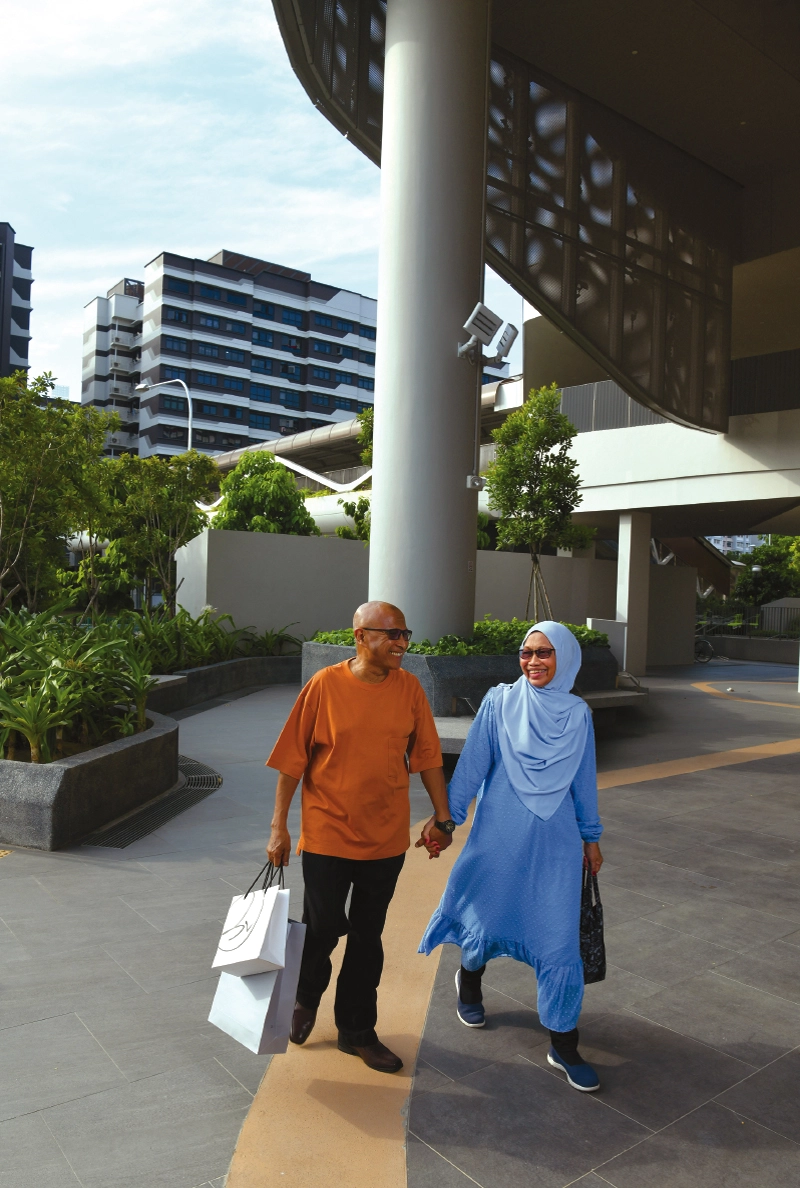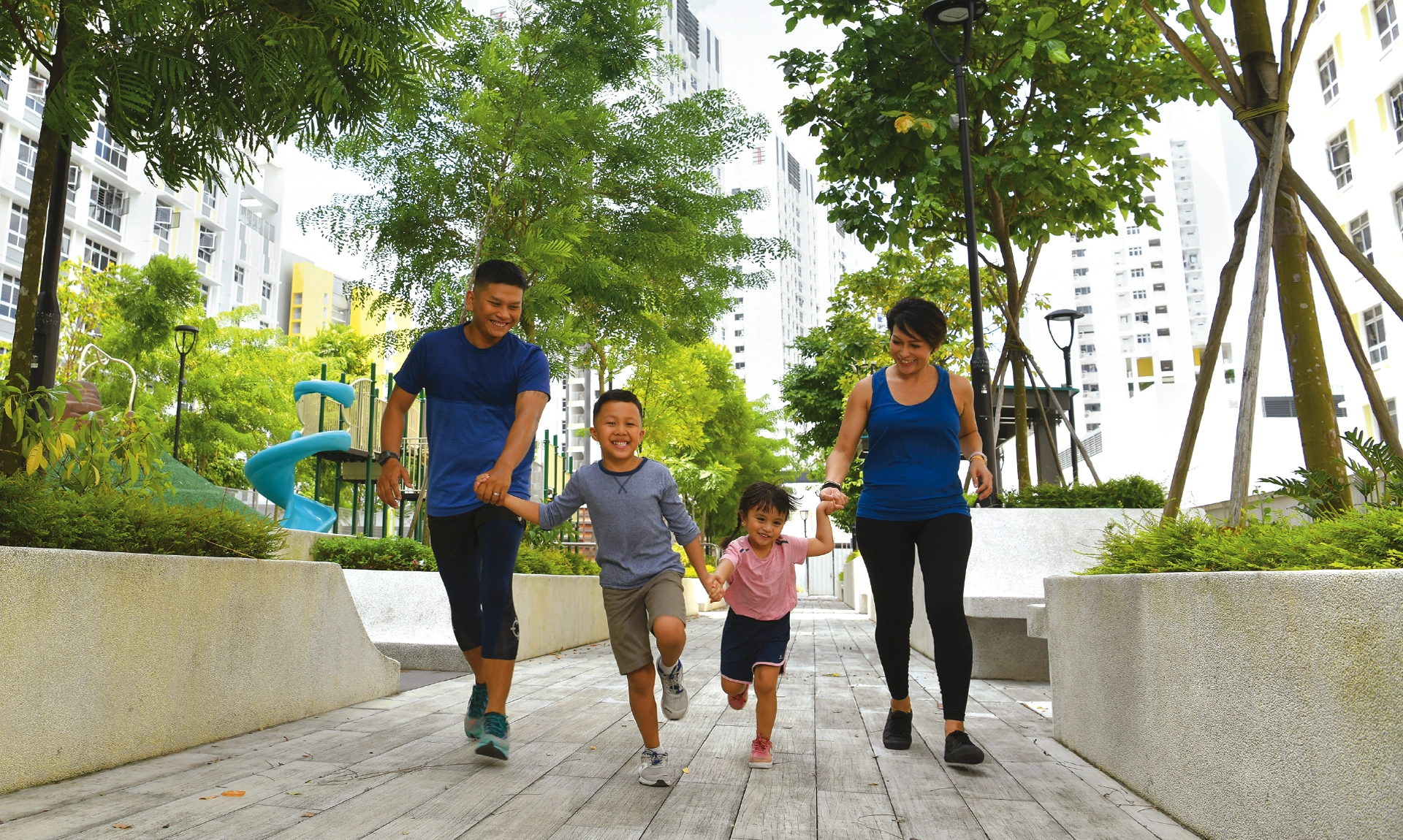Smart Living arrives at Punggol Northshore
The completion of Northshore Residences I and II in the Punggol Northshore district marked a major milestone in HDB's smart journey. Punggol Northshore is the first smart and sustainable housing district where HDB had test-bedded smart technologies to create a more liveable, efficient, sustainable and safe living environment for residents.
Smart-enabled homes piloted in Punggol Northshore are the first HDB flats to be equipped with additional infrastructure such as smart distribution boards, an additional power and data point to monitor electricity usage across household appliances to better manage energy consumption within their homes, as well as to facilitate residents' adoption of smart home solutions offered by commercial providers.
Outside the home, HDB implemented smart initiatives in Punggol Northshore to make daily living more comfortable for residents. Environmental Modelling, which simulates how environmental factors such as wind flow and sunlight interact, was used to guide the design of the district. For example, greenery was placed to alleviate potential hotspots, and outdoor amenities situated in well-shaded locations to create a pleasant living environment.
The reliability of estate services is further enhanced with smart technologies. For example, motion sensors and smart analytics are used to adjust lighting levels at common areas based on human traffic patterns, thus reducing energy consumption. Other features such as smart locks for services rooms reduce reliance on manpower in accompanying service personnel who carry out maintenance. Together with Smart Parking, Punggol Northshore presents a glimpse of how smart solutions in public housing can enhance the HDB living experience.

Parc Residences @ Tengah will be integrated with a Neighbourhood Centre and polyclinic, offering residents an array of amenities and services at their doorstep
Greener Towns on the Horizon
The HDB Green Towns Programme, announced in March 2020, aims to improve residents' quality of life and make all HDB towns more sustainable by 2030. The programme focuses on 3 key areas - reducing energy consumption by adopting solar energy and smart LED lighting solutions; recycling rainwater for non-potable uses; and cooling HDB towns via cool coatings applied to buildings, and intensifying greenery around HDB estates. These aim to reduce annual energy consumption in HDB towns by 15% from 2020 levels.
Tengah, HDB's newest town, will offer green living amidst nature. All 5 housing districts in Tengah will feature biophilic landscapes to connect residents more closely to nature, enhance biodiversity, and mitigate the environmental impact of climate change.
One of the housing districts, Park District, is being progressively developed. In August 2020, HDB launched Parc Residences @ Tengah, a BTO project which will be seamlessly integrated with a neighbourhood centre and a polyclinic. Residents can expect to enjoy smart infrastructure that can make their living experience more sustainable and convenient.
In Bidadari estate, which is envisioned to be a tranquil urban oasis, quality homes are set within verdant greenery and convenient amenities. Within the developments, rooftop gardens, courtyard gardens, and common greens with playgrounds and fitness stations are strategically located so Bidadari residents can enjoy nature at their doorsteps. All 12 planned public housing developments within Bidadari have been launched, with the last 3 projects launched in the February 2021 sales exercise.
As the largest driver for installation of solar photovoltaic (PV) systems in Singapore, HDB remains committed to accelerating usage of green energy. In FY2020, the fifth SolarNova tender was awarded to install solar PV systems at 1,154 HDB blocks and 46 government sites, with a solar PV capacity of 60 MWp to be reaped islandwide � the equivalent of powering 16,000 4-room flats with clean energy for a year. The sixth tender, called in March 2021, will see both solar panels and smart electrical sub-meters installed at HDB blocks. The latter can monitor and analyse energy consumption patterns and the performance of common services, in line with HDB�s efforts to harness smart technologies to develop smart estates.
As part of efforts to intensify the greening of its estates under the HDB Green Towns Programme, HDB worked with the Singapore Food Authority (SFA) to rent out rooftops of HDB multi-storey carparks (MSCP) for urban farming. These MSCP rooftops will be used to farm vegetables and other food crops, and for other related purposes such as the packing and storage of produce.

New-generation Neighbourhood Centres like Canberra Plaza are well-linked to surrounding housing precincts and provide a variety of social, communal, and recreational facilities for residents
Transforming the Heartland Retail Experience
In the FY, there were 17,860 commercial properties under HDB�s management, with the average occupancy rate remaining high at 96%. 460 commercial units were allocated and 95 shops/ eating houses were completed in the FY.
HDB piloted 2 mobile apps, RetailerLink and ShopperLink, to help enhance the heartland retail experience through the use of e-commerce tools. RetailerLink offers HDB retailers a one-stop digital platform to better engage their customers and promote their businesses to a wider audience. The app for customers, ShopperLink, provides users with the latest promotions and events happening at HDB Malls, and personalised updates from their favourite shops.
RetailerLink and ShopperLink were launched in December 2020 and January 2021 respectively for beta trial at Oasis Terraces. As at March 2021, all 94 retailers at Oasis Terraces are onboard the RetailerLink app, and over 5,000 customers have signed up for ShopperLink. HDB will progressively expand the use of these apps to other new-generation Neighbourhood Centres and HDB malls.
Helping Our Heartland Businesses
To help support businesses impacted by COVID-19, assistance measures were introduced as part of the 2020 Budgets. In the FY, qualifying tenants in HDB shops and Social-Communal Facilities received 4 months� worth of rental rebates in total, while qualifying tenants in HDB Offices received 2 months� worth of rental rebates in total.
Additional rental waivers were granted on a case-by-case basis last FY to help businesses severely impacted by the pandemic. HDB also offered flexible payment plans upon request and waived late payment charges for arrears. Majority of tenants who renewed their 3-year tenancy in 2020 also received a downward adjustment in rental, in line with market conditions.

Artificial Intelligence (AI) and machine learning technologies will be applied to video feeds captured on drones and robotic systems to automatically identify safety lapses in real time
Driving Construction Productivity
With continued application of innovative technology and initiatives, HDB achieved an overall productivity improvement of 25.9% for projects completed in 2020, compared to the base year of 2010. For flats launched in 2020, 30% of flats adopted Prefabricated Prefinished Volumetric Construction, while 68% of the flats adopted Advanced Precast Concrete System, resulting in 98% of flats adopting Design for Manufacturing and Assembly technology. Virtual Design & Construction (VDC) methodology was applied to 50% of flats launched in 2020. Using 3D modelling tools to create virtual reality mock-ups, VDC helps the team map out and review design plans and coordinate construction activities holistically.
HDB and the Agency for Science, Technology and Research (A*STAR) inked a research collaboration agreement to develop and adopt 5G-enabled smart construction technologies, and a memorandum of understanding to facilitate partnerships and commercialisation of the research outcomes. The research collaboration will include the research and development of a system that will capture videos, images and data through the use of sensors on robots and drones.
The system, leveraging the 5G network, could progressively develop 3D rendering of a construction project as it is built, while remotely monitoring the activities at construction worksites when the robots and drones are deployed. The system could also tap on Artificial Intelligence and machine learning technologies to automatically identify safety lapses and detect potentially unsafe behaviours and conditions at construction sites.
Resuming Construction Works Safely and Mitigating Delays
The measures imposed during the Circuit Breaker period had suspended construction activities and disrupted the supply of materials and manpower from overseas. Though HDB progressively resumed works in the third Quarter of 2020 amid the evolving pandemic situation, construction progress was further affected by strict adherence to various safe management measures aimed at preventing major COVID-19 outbreaks.
To reduce construction delays to our projects, HDB worked with the relevant authorities to shorten the approval process for various permits at each construction stage, and allow less noisy construction activities to be carried out on weekends and public holidays where possible. These measures were taken while ensuring that the quality of projects is not compromised. Affected flat buyers were notified of the revised completion dates, and those who were unable to find alternative housing arrangements were offered assistance where possible.
Upgrading Homes and Towns
In the FY, 18,595 flats were upgraded under the Home Improvement Programme (HIP). HIP helps home owners address common maintenance issues associated with wear and tear. Similar to BTO projects, HIP was affected by the COVID-19 pandemic, with works suspended during the Circuit Breaker period to ensure the safety of our residents. Construction works for HIP projects have resumed progressively from August 2020.
The HIP package was also refreshed to include more modern and better quality items, one of which is the External Retractable Clothes Drying Rack, which enables residents to dry clothes more safely without lifting heavy laundry bamboo poles in and out of their windows. This new laundry rack will be offered where feasible, to about 230,000 flats built between 1987 and 1997 that are now eligible for upgrading under the extended HIP.
When households are polled for HIP, they also get the choice to opt for the Enhancement for Active Seniors (EASE) programme. EASE aims to create a safer and more comfortable living environment for seniors through the installation of elderly-friendly fittings at subsidised rates. To date, close to 55% of the polled households have chosen to do so. Separately, about 88,800 households have applied for EASE directly since its pilot launch in July 2012.
The Neighbourhood Renewal Programme (NRP) focuses on precinct and block-level improvements. In the FY, 12 NRP projects were announced and 13 NRP projects were completed. This brings the total number of completed projects to 95 since the introduction of NRP in 2007.
*The 'Live Smart' pillar has been renamed 'Live Green' to better reflect HDB's commitment and ongoing contributions to Whole-of-Government sustainability efforts.
